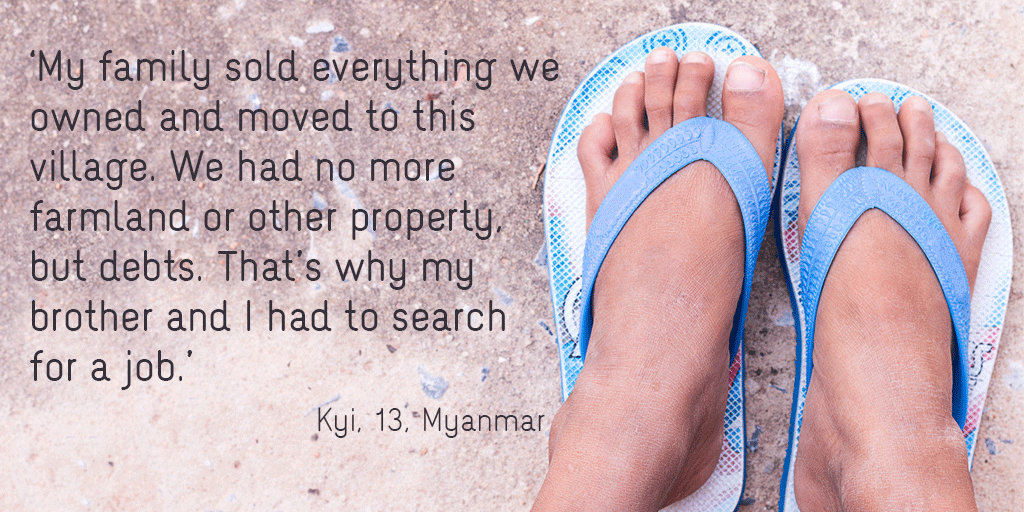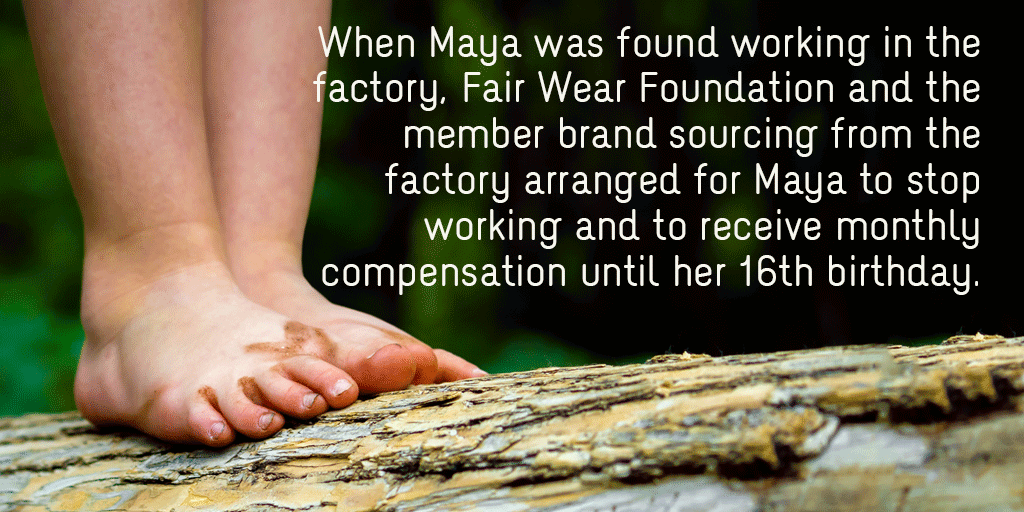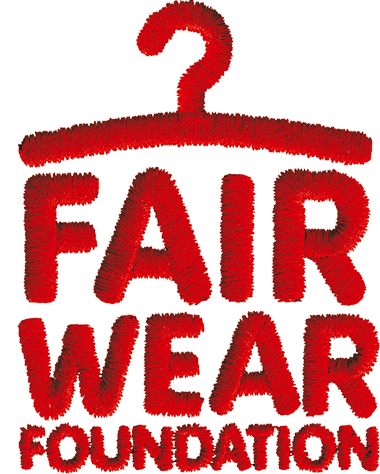Change starts with transparency. This publication seeks to promote a greater understanding of the realities of child labour by presenting interviews with children who were found working in Asia’s garment sector.
DownloadWorld Day Against Child Labour: Stories from Myanmar
On this #WorldDayAgainstChildLabour, we share stories of child workers in garment factories.
Child labour is a global problem. An estimated 218 million children around the world (aged 5-17) work, 70% of whom are considered victims of child labour. Life in a garment factory is difficult, but particularly so for children. Like other garment workers, they face long working days; 60-70 hours per week is standard. The work is physically demanding and also mentally harmful. The following stories are taken from taken from an upcoming FWF report on child labour in Myanmar. Please note that all names have been changed for privacy reasons.
Sadiya: Forced to work after her father’s injury
Poverty is one of the main factors that push children into work. Sadiya started working after her father broke both his arms in a work-related accident. Due to the financial strain on the family, she was forced to quit school, and found a job in a garment factory.
The job was difficult. She explains, ‘In times of high demand, the workers have to work all night’ with a one-hour break for a nap on the concrete floor at dawn, after which they continued to work the whole next day. The family’s financial situation left her feeling that she was unable to miss work, even when she was ill or exhausted.
After Sadiya and other child labourers were discovered, FWF, the member brand, and local NGOs, put a remediation plan in action to offer support, compensation, and the opportunity to return to school or pursue vocational training.

Kyi: Forced to work after her family lost their home
When severe flooding and river bank erosion claimed one family’s property, Kyi reflected on how they were forced to move to a house in a squatter area. ‘My family sold everything we owned, including a flock of ducks that we bred, and moved to [this village]. We had no more farmland or other property, but debts. That’s why my brother and I had to search for a job.’ A few days after the move, Kyi found work at a local garment factory. She was only thirteen.
After FWF representatives met her, with the support of FWF and the member brand sourcing from the factory, she was removed from the factory, given compensation and the opportunity to take a tailoring course at a local training centre. Kyi shared that she hopes to further her skills in the future and set up her own tailoring business after she turns sixteen.

Maya: Working without rest for 10 hours per day
Maya comes from a poor fishing community in Bago Region, Myanmar. She quit school at the age of 12 when her parents could no longer afford to pay her school fees. She then went to work in a factory in Yangon.
Maya says that she initially felt very out of place at the factory and was so afraid that she did not dare speak or look at the other workers. She was assigned to feed shirt buttons into tiny holes in fabric, a task that required her to stand without rest for 10 hours each day. ‘My fingertips became swollen and painful, but I had to work standing constantly without even having a few minutes to sit and rest. My legs are also becoming stiff and painful.’
When FWF found out that Maya was working in the factory, FWF and the member brand sourcing from the factory arranged for her to stop working and for her to receive monthly compensation until her 16th birthday, including a guarantee to rehire her if she should wish to return when she reached the legal age for working.
What happens when child labour is discovered?
When a child labourer is found in a factory, FWF takes the necessary action to investigate, including a home visit to ascertain whether the child wants to go back to school or pursue some form of vocational training. Child labourers are denied their dignity and their childhood, but also their potential to dream. FWF, and its member brands, are committed to protecting the rights of children and addressing child labour in garment factories.
To better understand the experiences of child labourers, FWF will be issuing a report based on the experiences of children identified at garment factories in Myanmar in the coming weeks.
Take a look at our work in Myanmar and our Code of Labour Practices which includes no exploitation of child labour.
Child Labourers and the International Day of Innocent Children Victims of Aggression
Today, 4 June, marks the International Day of Innocent Children Victims of Aggression. No child should be forced to work, yet child labour is all too prevalent in the garment industry. This situation is often exacerbated by war and conflict.
The Syrian war has had a significant impact on children with many ending up in neighbouring Turkey. Of the 3.5 million Syrian refugees registered in Turkey, around 1.1 million are school-aged children. Child victims of war are often forced to work to support their families. Despite efforts of the Turkish government and the international community in providing substantial aid, stakeholders in Turkey have reported a sharp increase in child labour since the arrival of Syrian refugees.
One of Fair Wear Foundation’s labour standards is no exploitation of child labour. When child labour is found in a garment factory from which a FWF member brand sources, FWF together with the brand takes the steps needed to assist child labourers. It is important that the brands continue to work with the factory and not pull their business away. This reaction could have disastrous effects on the factory and the children. Together, the brand and FWF ensure that the child returns to school and that the family receives financial compensation for lost wages.
Additionally, FWF works with its Turkish stakeholders to address issues faced by Syrian refugee workers in the garment industry. FWF informs its brands and suppliers on specific risks and offers guidance by holding webinars and roundtables to further their understanding on procedures such as accessing work permits. FWF also provides a local complaints helpline in Arabic for workers with concerns and those wishing to report violations.
For more information, see FWF’s Guidance for Members: Risks related to Turkish garment factories employing Syrian refugees and the FWF child labour policy. Stay tuned for an upcoming detailed report about the labour situation of Syrian refugees in Turkey.
Myanmar factories gather to discuss age verification
FWF looks back on a successful supplier seminar in Myanmar on the topic of age verification. In November, factory representatives, agents and FWF experts exchanged ideas on how to establish a more robust age verification system to prevent child labour. This discussion culminated in a simple FWF guideline.
In Yangon, over 30 representatives of 16 garment factories that produce for FWF member companies came together. With local FWF staff, they exchanged ideas and mechanisms to create a strong age verification system. The participants started off by sharing practical challenges related to age verification.
False ID
Due to high labour mobility from rural to urban commercial centers like Yangon, along with the lack of proper identification documents, it is challenging for factories to verify the age of every worker. Many youth lack ID cards or create falsified ones to apply for a job. Also, in times of high demand, factories recruit new workers without requesting the necessary documents.
A factory’s CSR officer: ‘We recruited a new worker, not knowing that he was a child labourer. But after employing him for some time, we found out that the worker had used falsified documents during the recruitment process. Then, all the responsibility fell upon the factory and we had to provide compensation until he turned 16. That doesn’t seem fair.’
FWF Guidance
Taking all the factories’ challenges into account, FWF introduced a simple age verification guideline to help prevent garment factories from recruiting children, even unwittingly. The guideline strongly recommends the factories to follow six steps of good practices for age verification whenever they recruit new workers.
These six age verification steps are: 1) Child labour policy; 2) Document check; 3) Interview with the candidate worker; 4) Medical check; 5) Checklist to document all HR steps for age verification; and 6) Training of HR staff.
You can read FWF’s Guidance on age verification at garment factories in Myanmar here.
Age verification Myanmar – FWF guidance
A practical Guidance Document to help garment factories in Myanmar to set up a more robust Age Verification System. It is intended for use by top and middle management (HR staff in particular) of garment factories in Myanmar that supply FWF member companies.
DownloadBrands play large role in tackling child labour
Clothing brands can learn from their peers who dare to be honest about finding child labour in their supply chains, know the risks, try to limit them whenever possible, and take action where necessary. That is the essence of an FWF op-ed that the Business and Human Rights Resource Centre published on its website today.
On behalf of a group of FWF brands, FWF wrote a letter on how garment brands can work together on eradicating child labour. In the letter, brands of Fair Wear Foundation are unusually transparent about child labour in (their) garment supply chains. The cases of Syrian refugee children in Turkey and a garment factory in Myanmar are highlighted as examples of good practices.
Small group of brands
Child labour is still a widespread problem in many sectors, including the garment industry. Garment brands can play an important role in tackling this problem. However, that doesn’t happen enough. FWF brands are not the only ones who have found child labour in their supply chains, far from that. But still, they are part of only a small group of brands who are seriously working on it.
The letter shows that there are steps that garment brands can take towards tackling child labour, using their economic influence. FWF hopes that the letter will motivate other brands to take action too. If more brands were to also step up, FWF members and the industry in general could act more effectively when child labour is discovered.
Hamza and Osman
Child labour is a serious risk in Turkish garment factories. Although it had been on the decline in recent years, the influx of Syrians fleeing the conflict turned the tide. In 2014, FWF auditors spotted the Syrian Hamza (14) and Osman (13) at work in a Turkish textile factory. FWF members sourcing from the factory took responsibility for getting the children out of the factory and back to school for them.
Read more about this case in FWF’s long read on child labour in Turkey: How the Syrian conflict is impacting the Turkish garment sector.
Myanmar Complaint Mammut, OSC, Deuter Dec. 2016 Final Report
Final report of a complaint at a factory in Myanmar supplying Mammut Sports Group AG, Outdoor & Sports Company Ltd, and Deuter
On 16 December 2016, FWF received an advanced notice of a report on labour conditions and social issues in the export-oriented garment industry in Myanmar. Shortly thereafter the report was also shared by SOMO with all the FWF member brands that are sourcing in Myanmar. This draft research report included findings about alleged child labour at a factory supplying several FWF member brands. FWF decided to treat this case as a complaints procedure on 4 January 2017. FWF staff conducted an interview with ALR (the organisation that conducted the worker interviews for the SOMO research) and conducted 30 off-site worker interviews before visiting the factory unannounced. During this investigation, one child worker aged 15 years and 5 days was identified. The worker has been working in the factory sewing department since 23 April 2015, and was 13 at the time of recruitment. 12 young workers, age between 16.3 to 17.8 years old, were identified as working in the factory.
The factory management team, with which the preliminary findings were shared, took the situation very seriously and was very concerned about the findings. Stakeholders reported that the use of fake and borrowed ID cards is widespread in Myanmar. This was also the case here as the worker confirmed that she applied with a fake (i.e. borrowed) ID Card. FWF concludes that there was no intentional child labour at the factory.
FWF introduced suggested remediation, which meant that the child worker would need to stop working and that the family be compensated for income. Education should be arranged until the child turns 16, at which point the worker could be reinstated if desired. A medical certificate of fitness would need to be arranged for all workers under 18. With the support of the brands, the factory has committed to the above remediation steps. FWF is monitoring the remediation and has also verified that certificates of fitness were arranged for all the young workers. The child worker expressed satisfaction with this solution.
DownloadRoundtable Turkey: integrating Syrian refugee workers
Garment brands, factories, unions, the Turkish government, international organisations and other stakeholders gathered in Istanbul on Monday to discuss challenges and possible solutions for integrating Syrian refugee workers. The roundtable was organised by Fair Wear Foundation.
“The turnout was quite high”, said FWF’s Andriëtte Nommensen, who organised the meeting. “The participants covered the whole spectrum that is needed to address the issue of Syrian refugees in Turkish garment factories.”
Tackling child labour
In his opening speech, Dutch ambassador Cornelis van Rij praised Turkey for taking up so many refugees, and FWF for actively trying to tackle child labour in the country. He said he hoped that the organisations that were present would be able to work together on possible solutions.
The meeting resulted in an outline of next steps that the Dutch and Turkish governments, brands and factories, and civil society organisations can take. Possible solutions mentioned include improved labour inspections and an easier way to get work permits for Syrian refugees.
Remediation
The participants also emphasised the role of European brands. They can take responsibility by getting better insight into their supply chains, including subcontractors, put less pressure on the price and play an active role in remediation when children are found.
Fair Wear Foundation requires its members to ensure that all suppliers have a policy in place for registering Syrian refugee workers; see the FWF guidance for members sourcing in Turkey.
Read more about the difficulties of eradicating child labour in garment supply chains and possible solutions in this FWF article.
If you want to learn more about the Turkish garment industry, read FWF’s latest Turkey country study.
Child labour in Turkey: How the Syrian conflict is impacting the Turkish garment sector
Child labour in Turkey: How the Syrian conflict is impacting the Turkish garment sector
The Syrian conflict may seem distant to fashion companies and consumers, but the war is having a direct impact on the garment sector through its supply chain. A growing number of Syrian children, hired in violation of International Labour Organisation (ILO) conventions that prohibit child labour, are used as cheap manpower in Turkish textile factories.
Brands that only account for a small percentage of a factory’s production have limited leverage to demand changes, which is why FWF encourages cooperation between members sourcing from the same suppliers to boost their influence. “If you’re lucky enough to find other FWF members working with the same manufacturer, this is the best case scenario,” says Sven König. “You can combine corrective efforts and have more leverage, more impact.” Vaude won the 2015 FWF Best Practice award for a joint training project conducted in cooperation with two other companies, Jack Wolfskin and Salewa.
Fair Wear Foundation is in favour of working together with other multi stakeholder initiatives like FLA and ETI.
Creating an environment in which garment companies can be more honest about the darker sides of the industry and engage constructively with their suppliers would be an important step towards preventing child labour. “We want brands to be frank and open about it,” says Margreet Vrieling of FWF. “Brands and suppliers must give each other room to do business in a respectful way.”
Author: Nicole Pope – for Fair Wear Foundation
DownloadVietnam version of FWF Formula now online
FWF is pleased to announce that the Vietnamese version of the Fair Wear Formula film is now available online







